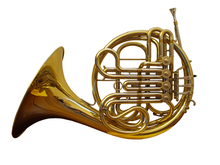French horn
The horn is a brass instrument that consists of tubing wrapped into a coiled form. The instrument was first developed in France from the cor de chasse, or hunting horn in about 1650. Since 1680, when the instrument was used in England, it has been known as the French horn in English-speaking countries, (although musicians, particularly players of the instrument, generally refer to it simply as the horn). In 1971, the International Horn Society declared the official name of this instrument to be the "Horn."

The horn is a conically shaped instrument much like the cornet and Saxhorns. It has a tapered bore which steadily increases in diameter along its length, unlike the trumpet and trombone which are considered cylindrical. Unlike most other valved brass instruments, which use piston valves, the horn uses rotary valves. Piston valves are of French origin. The earlier horns used pistons, but then changed to rotary valves, of German origin, to save space.
Compared to the other brass instruments commonly found in the orchestra, the typical range of the horn is set an octave higher in its harmonic series, facilitated by its small mouthpiece. A typical horn contains twenty-six feet of tubing (the longest of any instrument). Its conical bore is largely responsible for its characteristic tone, often described as "mellow". The typical playing range of a horn differs from its written range by a fifth, and extends from the G below the treble clef to the F above the treble clef. Although this is the standard range found in classical repertoire, some players can play many notes beyond this range, both lower and higher.
The horn typically plays higher in its harmonic series than other common orchestral brass instruments, where the partials are closer together (and harder to distinguish), making the horn one of the more difficult instruments to learn.
Famous Horn players
editEmma Maher
Dennis Brain
Eric Ruske
Peter Damm
Barry Tuckwell
David Gent
Dale Clevenger[1]
Philip Farkas